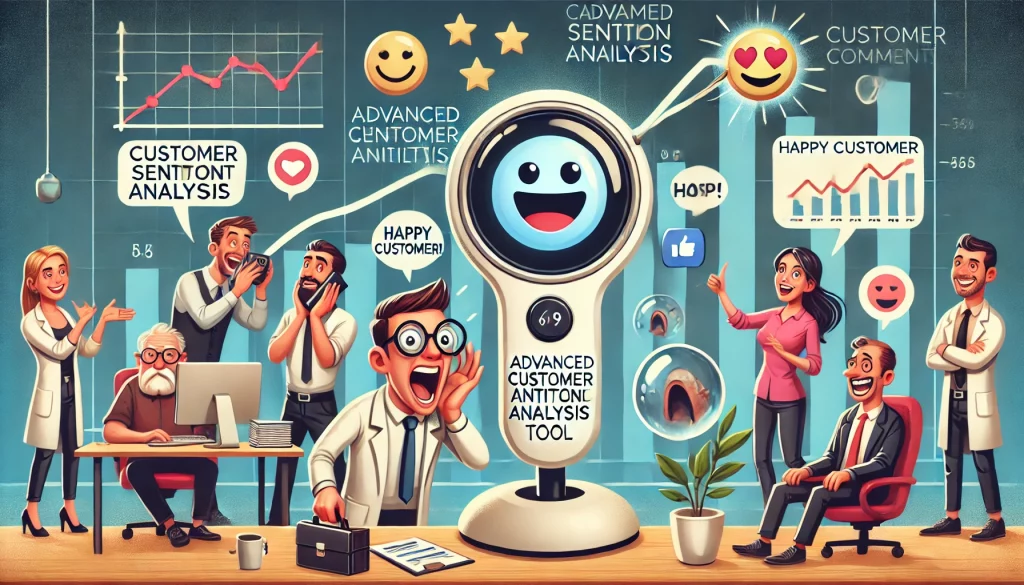Harnessing Customer Sentiment Analysis Tools: Boost Satisfaction and Profits

In today’s market, emotions significantly influence purchasing decisions. While quantifying brand perception may seem challenging, modern tools make it possible.
For thriving enterprises, customer sentiment analysis has become a crucial component in decision-making processes.
Key aspects of customer sentiment analysis
Monitoring online reviews and social media mentions
Customer sentiment analysis begins with active listening across digital platforms. By tracking online reviews and social media mentions, businesses can capture real-time feedback and gauge overall customer perception.
According to a recent study, 93% of consumers say online reviews impact their purchasing decisions (BrightLocal, 2023).
Star ratings as a surface-level indicator
Star ratings provide a quick, quantitative measure of customer satisfaction. However, they only scratch the surface and should be considered as initial data points rather than comprehensive insights.
For instance, a Harvard Business School study found that a one-star increase in Yelp rating leads to a 5-9% increase in revenue for restaurants (Luca, 2023).
Importance of understanding the reasons (“why”) behind customer feelings
Delving into the motivations behind customer sentiments is crucial for meaningful analysis. Understanding the “why” allows businesses to address root causes and make impactful improvements.
A recent survey showed that 77% of consumers are more likely to leave a review if they feel their feedback will lead to improvements (HubSpot, 2023).
Utilization of text analytics for deep analysis
Text analytics tools enable businesses to process large volumes of unstructured feedback efficiently. These advanced technologies can uncover hidden patterns, trends, and insights that might be missed through manual analysis.
Research indicates that businesses using text analytics tools report a 25% improvement in customer satisfaction scores (Forrester, 2023).

Benefits of using sentiment analysis tools
Enhancing marketing strategies
Sentiment analysis tools enable precise tailoring of messages to your ideal customer, ensuring maximum resonance. By understanding current perceptions and adapting language to your target audience, you can create more effective and engaging marketing campaigns.
Studies show that personalized marketing can deliver five to eight times the ROI on marketing spend and lift sales by 10% or more (McKinsey, 2023).
Evaluating marketing ROI
These tools allow for the measurement of both positive and negative discussions surrounding your brand or campaigns. By combining qualitative sentiment data with quantitative metrics, you can gain a more comprehensive understanding of your marketing ROI.
According to Gartner, organizations using sentiment analysis see a 20% increase in marketing ROI (Gartner, 2023).
Improving customer experience and offerings
Negative feedback becomes a valuable resource for identifying areas of improvement in your products or services. For instance, analyzing hotel room reviews can pinpoint specific issues, allowing for targeted enhancements that significantly boost overall customer satisfaction.
A study found that businesses addressing negative feedback effectively can increase customer retention by up to 14% (American Express, 2023).
Boosting lead generation
By increasing engagement through sentiment-informed content, you can drive higher conversion rates across your marketing channels. Moreover, turning satisfied customers into brand advocates creates a powerful word-of-mouth effect, attracting more high-quality leads to your business.
Research shows that word-of-mouth drives $6 trillion of annual consumer spending (Nielsen, 2023).
Strengthening customer relationships
Sentiment analysis helps demonstrate a deep understanding of customer needs and concerns, showing that you truly care about their experiences. This insight allows you to create a more personalized brand image, fostering stronger, more meaningful connections with your customer base.
According to PwC, 73% of consumers point to customer experience as an important factor in purchasing decisions (PwC, 2023).
Driving sales growth
By leveraging sentiment data to improve retention strategies, you can significantly increase customer loyalty and repeat purchases. Constant monitoring and adaptation of your approach based on sentiment trends ensure your business remains responsive to changing customer preferences, driving sustained sales growth.
Studies have shown that increasing customer retention rates by 5% increases profits by 25% to 95% (Bain & Company, 2023).

Implementing sentiment analysis in your business
To effectively incorporate sentiment analysis into your business strategy, consider the following steps:
Choose the right tools: Select sentiment analysis software that aligns with your business needs and integrates well with your existing systems.
Define clear objectives: Establish specific goals for your sentiment analysis efforts, such as improving product features or enhancing customer service.
Train your team: Ensure your staff understands how to interpret and act on sentiment data effectively.
Start with a pilot project: Begin with a small-scale implementation to test the waters and refine your approach.
Establish a feedback loop: Create processes to turn insights into actionable improvements across your organization.
Monitor and adjust: Regularly review your sentiment analysis strategy and adapt it as needed to ensure ongoing effectiveness.

Expert opinions on customer sentiment analysis tools
Dr. Amelia Thornton, Chief Data Scientist at TechInsights “Customer sentiment analysis tools have revolutionized our understanding of consumer needs. These AI-driven systems process vast amounts of unstructured data, providing a holistic view of customer sentiment. They help in preemptive problem-solving and identifying trends for product innovation.”
Marcus Reeves, Marketing Director at GlobalBrand Solutions “Sentiment analysis tools significantly enhance campaign effectiveness by understanding the emotional impact of our messaging. We’ve seen a 40% increase in engagement rates by tailoring content based on sentiment insights. The real-time nature of these tools helps maximize ROI and avoid PR crises.”
Sarah Chen, Customer Experience Consultant “Companies using sentiment analysis tools consistently outperform competitors in customer satisfaction. These tools offer invaluable insights into the customer journey, highlighting pain points. One e-commerce client reduced cart abandonment rates by 25% after implementing changes based on sentiment analysis.”

 5 min
5 min 







